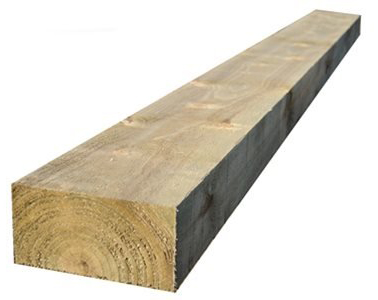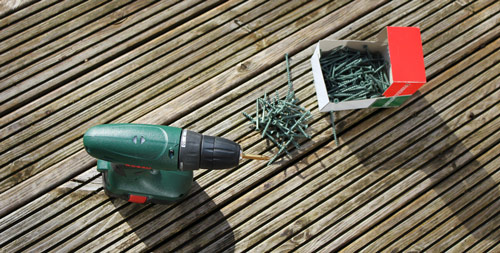The Different Uses of Timber Sleepers
What are timber sleepers?
Sleepers, derived from the name railway sleepers, after the fact they were once used to support railway tracks, are large pieces of timber that can be used for a variety of gardening and landscaping projects.
There are three main types of sleepers; original reclaimed railway sleepers which served as support for railway tracks, softwood sleepers and hardwood sleepers.
Typically, reclaimed sleepers are popular for their look but usually heavily treated with creosote due to the industrial purpose they were originally used for which can now be seen as dangerous for health reasons as well as having a negative impact on the environment.

And new railway sleepers which are very common for landscaping projects due to their strength, versatility, easy to stack and handling and can be bought in either softwood or hardwood.
In this article we will explore the various uses of sleepers across different industries, including benefits and drawbacks.
Softwood vs. Hardwood Sleepers
Softwood sleepers are large, sawn-cut rectangular pieces of timber made from faster growing trees where the wood is not as dense, such as pine or spruce. To enhance the life and prevent rotting, softwood sleepers are often pressure treated with preservatives.
Hardwood sleepers are crafted from oak or teak, a dense and durable wood specie. Hardwood sleepers tend to be heavier compared to their counterpart softwood sleepers and do not require treatment due to their natural dense and durability.
How long do sleepers last?
The life of sleepers depends on what type of wood is used, where the wood originates from as well as the environmental conditions they are exposed to. For example, oak sleepers will have a naturally longer life.
If purchasing UC4 incised sleepers where the treatment penetrates further into the wood, the life expectancy is increased to, where some sawmills recommend a life of 25 years. If untreated, and used directly on ground, the life expectancy is said to decrease.
How do you maintain softwood timber sleepers?
Overtime, wood will change colour due to the exposure to UV rays, weathering and pollution as well as naturally being exposed to rot and infestation. It is therefore recommended that sleepers are treated 6-12 months, ideally in the Spring and Autumn to prevent the timber from these natural processes.
If using treated sleepers, no initial treatment is required prior to installation. However, if the sleepers are cut to the required size, the exposed end will need a coat of preservative. The correct application will protect against sun damage, while waterproofing and preventing sooner infestation and rot.
If untreated sleepers are being used, treating them with most types of shed treatment, fence treatments or wood preservatives will prolong the life and prevent any rot damage or infestations.
To maintain the wood’s natural appearance, apply two coats of wax-free, clear wood preservative followed by one to two coats of clear exterior wood oil to maintain the life expectancy.
What is the difference between green and brown treatment?
Despite the name green treated, the timber colour is the natural wood with a hint of green due to the pressure treating process the timber has been exposed to. The green is a copper-based solution that is applied in a vacuum or other pressure treated plants, which then reacts with the air and oxides.
Brown treated timber follows the same process as green treated, however, the brown dye is added to the copper preservative mix allowing the timber to have a more natural look. The dye itself has no significance in extending the life of the timber and is used as a decorative finish.
Using Timber Sleepers in your garden
Timber sleepers have a variety of different end finishes; starting with raised beds and sleeper planters, as being the most popular choices. Having raised beds and planters made using sleepers helps reduce weeds, keep slugs away as well as reducing compaction, allowing soil drainage for a longer growing season. Sleeper planters tend to be smaller than sleeper raised beds with a fixed base for easier transportation.
A decorative finish such as sleeper steps and pathways are an attractive alternative to concrete or brick. It allows for a rustic yet contemporary finish. Designs can be versatile while adding a practical element, including segmenting areas of your garden, or acting as a diverted route through a grassed area.
Using sleepers as a retaining wall is becoming increasingly popular. Homeowners opt into using garden sleepers as a practical solution as well as allowing a more aesthetically pleasing look to your garden. Sleepers help prevent soil erosion by holding back the earth, especially in sloped areas.
Fixing sleepers together
There are several options when fixing sleepers together. Firstly, Timberlok Screws. These heavy duty, hex head screws are made from heat-treated steel. They are easy to install due to the anti-friction topcoat, no pre-drilling is required (except in the case of dense hardwoods), they countersink flush and are designed not to rust in pressure treated timber.
Brackets and steel plates are another option, including sleeper pins. Angle brackets are ideal for 90-degree connections in raised beds or retaining walls when a stronger corner joint is required, either instead of, or as well as Timberlok screws.
Flat connector plates are useful for connecting different layers of railway sleepers together when they are stacked on top of each other. They are also perfect for connecting a run of railway sleepers.
Posts or stakes are also another common way of fixing sleepers into place. In low level projects you will find that 50mm x 50mm stakes are useful when holding your railway sleepers in place. Simply knock them into the ground and screw the sleeper to them.
If sleepers are being stacked a little higher on top of each other, then they will require more support to stop them leaning forward or toppling over, and your retaining posts need to be stronger. That is where 100mm x 100mm traditional fence posts are used, which are thicker and longer lasting.












